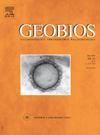鸟类颅颈形态整合
IF 1.6
4区 地球科学
Q2 PALEONTOLOGY
引用次数: 0
摘要
本研究探讨了冠类鸟类颈部的形态多样性及其与颅骨解剖的结合。颅颈关节,即颅骨与颈部相连的部位,可采用尾侧(后)或腹侧(下)方向。形态一致性对于维持头部稳定性和精确运动至关重要,这表明这些结构的进化不仅必须在功能上协调,而且必须在发育上协调(即形态上的整合)。为了探索这一假设,我们使用多元统计(回归和双块偏最小二乘法)评估了颈部的常规形态测量数据和颅骨的几何形态测量数据之间的关系。结果表明,颈部和颅骨形态之间存在显著的整合水平,其中颈部长度、椎体计数和相对长度的变化可预测地与特定的颅颈关节相对应。最明显的颅骨变异发生在枕区周围,我们认为这可能与所有颅颈骨的中胚层起源和形态发生中共享的遗传信号有关。此外,颅面变化与颅颈变化一致,这意味着颅骨和颈部作为一个统一的模块化系统进化。对选定化石(Tsaagan,始祖鸟和Pengornis)的分析表明,祖先的头颈结构是尾端的,颈部的变化与喙的发育和头颈腹侧化有关,在导致现代鸟类的谱系中出现。本文章由计算机程序翻译,如有差异,请以英文原文为准。
Craniocervical morphological integration in birds
This study investigates the morphological diversity of the neck and its integration with skull anatomy in crown-group birds (Neornithes). The craniocervical articulation, where the skull connects with the neck, can adopt either caudal (rearward) or ventral (downward) orientations. Morphological coherence is crucial for maintaining head stability and precise movement, suggesting that the evolution of these structures must be not only functionally, but also developmentally coordinated (i.e., morphologically integrated). To explore this hypothesis, the relationship between conventional morphometric data of the neck and geometric morphometric data of the skull were assessed using multivariate statistics (Regressions and Two-block Partial Least Squares) across a broad phylogenetic range of Neornithes. Results indicate a significant level of integration between neck and skull morphologies, where variation in neck length, vertebral counts and relative lengths correspond predictably with specific craniocervical articulations. The most pronounced skull variation occurs around the occipital region, which we interpret as possibly relating to the mesodermic origin and shared genetic signalling in the morphogenesis of all craniocervical bones. Additionally, craniofacial changes align with craniocervical modifications, implying that the skull and neck evolve as a unified yet modular system. Analysis of selected fossils (Tsaagan, Archaeopteryx, and Pengornis) suggests that the ancestral craniocervical configuration was caudal, with neck changes associated with the development of a beak and craniocervical ventralization emerging in the lineage leading to modern birds.
求助全文
通过发布文献求助,成功后即可免费获取论文全文。
去求助
来源期刊

Geobios
地学-古生物学
CiteScore
3.30
自引率
6.20%
发文量
28
审稿时长
6-12 weeks
期刊介绍:
Geobios publishes bimonthly in English original peer-reviewed articles of international interest in any area of paleontology, paleobiology, paleoecology, paleobiogeography, (bio)stratigraphy and biogeochemistry. All taxonomic groups are treated, including microfossils, invertebrates, plants, vertebrates and ichnofossils.
Geobios welcomes descriptive papers based on original material (e.g. large Systematic Paleontology works), as well as more analytically and/or methodologically oriented papers, provided they offer strong and significant biochronological/biostratigraphical, paleobiogeographical, paleobiological and/or phylogenetic new insights and perspectices. A high priority level is given to synchronic and/or diachronic studies based on multi- or inter-disciplinary approaches mixing various fields of Earth and Life Sciences. Works based on extant data are also considered, provided they offer significant insights into geological-time studies.
 求助内容:
求助内容: 应助结果提醒方式:
应助结果提醒方式:


